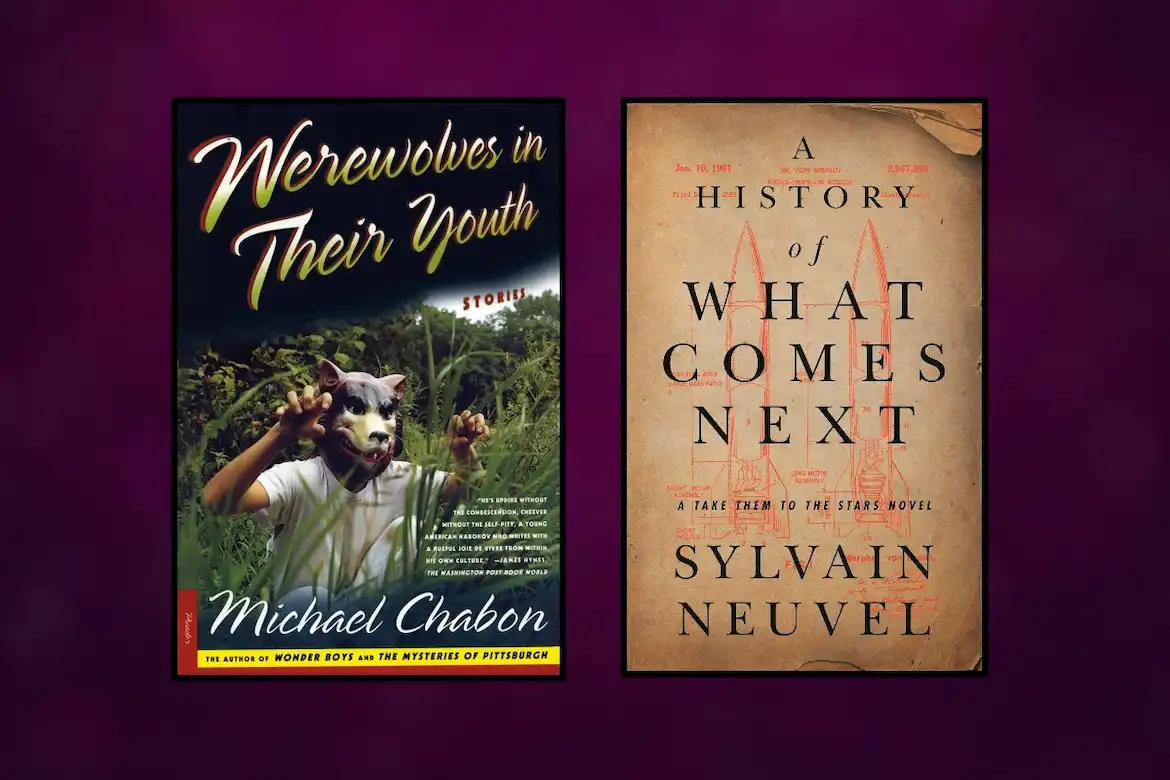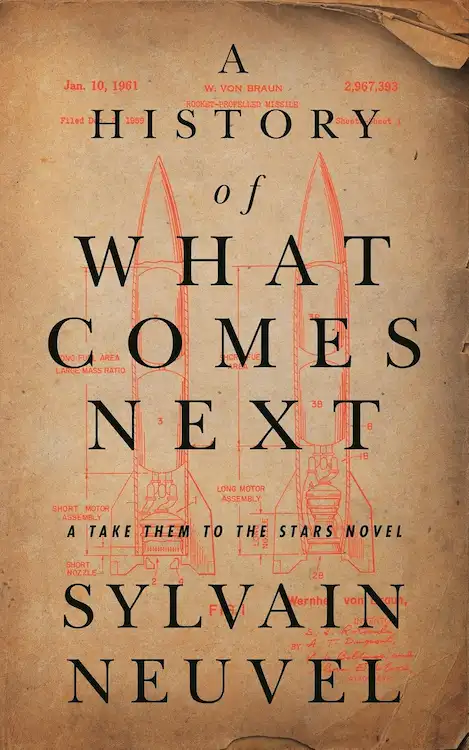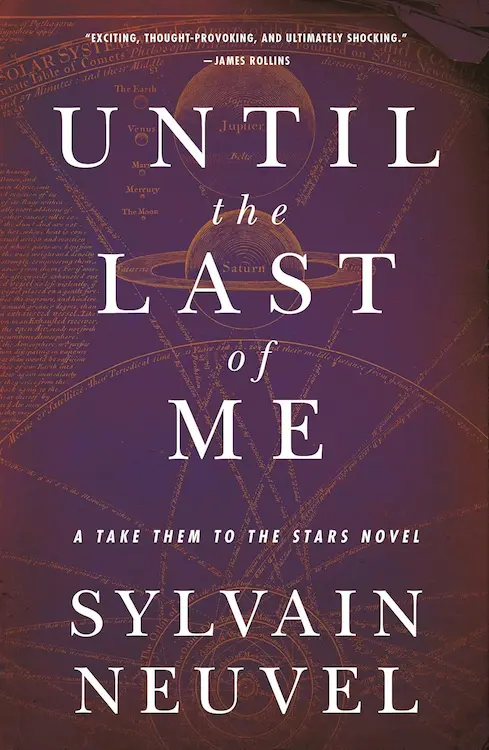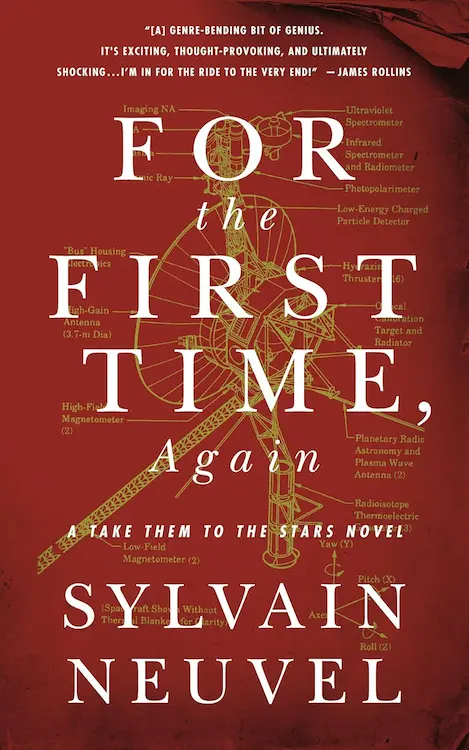In this LitStack Rec, we’re recommending Michael Chabon’s irresistible short story collection Werewolves in Their Youth, and Sylvain Neuvel’s A History of What Comes Next (a Take Them To The Stars novel)

In This LitStack Rec – Werewolves in Their Youth & A History of What Comes Next
Michael Chabon’s Werewolves in Their Youth isn’t exactly horror or sci-fi, though Chabon is famously a fan of both genres. And in this collection, published in 1999, there are hauntings, though they are by absent fathers, local drunks, past misdeeds, and guilty consciences. Characters move about in the placid light of
If there is a single idea that runs between stories, it’s not gruesome scenarios of the shadow world or the dead’s pursuit of the living. This is literary fiction after all, and rather than the darkness of beasts and monsters, each stylized glimpse looks at the darkness in relationships: matrimony, divorce, reconciliation, fatherhood, the raising of children, and fraught episodes in a marriage bed—these are the scary scenes at the heart of this collection.
In the title story, two friends escape into fantasy as a hedge against fatherlessness, and from the opening line, the premise connects to the author’s passion for comics, superheroes, pop culture:
“I had known him as a bulldozer, as a samurai, as an android programmed to kill, as Plastic Man and Titanium Man and Matter-Eater Lad, as a Buick Electra, as a Peterbilt truck, and even, for a week, as the Mackinac Bridge, but it was as a werewolf that Timothy Stokes finally went too far.”
In “Spikes,” an electric guitar maker whose marriage ended after the death of his child takes a troubled eleven-year-old under his wing; in “Green’s Book,” Marty Green, a divorced father, encounters a witchy-looking girl at a party, and a bad feeling of their history comes hurtling back; and in “The Harris Fetko Story,” a down-and-out football star comes to term with his absent father. Here’s Fetko at the mirror:
“He was used from long habit to thinking of his body as having a certain monetary value or as capable of being translated, mysteriously, into money, and if it were somehow possible, he would have paid a handsome sum to purchase himself.”
The collection includes a dip into actual horror with “In the Black Mill,” a long short story of an archaeologist who discovers cannibalism and ritual sacrifice in what is clearly a sinister Pennsylvanian town.
Though stylized, humorous, and consummate passages abound on nearly every page, my favorite story of the collection might be “House Hunting.” Daniel Diamond and Christy Kite are a young and seemingly ideal couple who, of course, possess a dark secret: despite being in their early twenties, blessed with health, wealth (via Christy’s parents), and the kind of comfort only a certain conformity can provide—they’re not getting along—that is to say, they’re not getting it on, as the saying goes, despite concerted efforts, and exhaustive counseling. Working with a therapist, the couple hopes to generate a “
Although sex was something they both regarded as perilous, marriage had, by contrast, seemed safe—a safe house in a world of danger; the ultimate haven of two solitary, fearful souls. When you were single, this was what everyone who was already married was always telling you. Daniel himself had said it to his unmarried friends. It was, however, a lie.
As the story opens, their real estate agent, Mr. Hogue, a family friend, is about to show them a house, one that seems out of their league. The house-hunting expedition of the story exposes the couple’s marital lie, and yet its darkness turns out to have, well, a silver lining. That’s how it goes with this collection: the landscape is familiar—all the better to employ the creepiness of so many dark undersides (and the author has too a love of obscure locales—Chagrin Harbor, Probity Beach, Chubb Island).
Each story mines the characters with a lively prose style that unwittingly pulls the reader into a dark and unknown landscape, and yet, despite the darkness, the characters eventually come to find hope. Thanks to Chabon’s careful observances and the signature stamina of his sentences, the result always gets beneath the beautiful surface of his prose.
Chabon won the Pulitzer Prize in 2001 for his novel, The Amazing Adventures of Kavalier & Clay, but for me, the short story is where the author’s talents are sharpest and his prose exacts its clearest effect. When you can describe ideas and things as well as Chabon does, it’s great to have the room to stretch out, but Werewolves in Their Youth is about as perfect as a collection can get: a glittering assembly of dark gems, each of which contains its own small flame of brightness.
—Lauren Alwan
About Michael Chabon
Michael Chabon is the bestselling and Pulitzer Prize-winning author of seven novels – including The Amazing Adventures of Kavalier & Clay and The Yiddish Policemen’s Union – two collections of short stories, and one other work of non-fiction. He lives in Berkeley, California, with his wife and children.
Okay, so I read Sylvain Neuvel’s highly touted debut novel, Sleeping Giants, and wasn’t as enthused as I had hoped to be. It was good, yes, but it just didn’t grab me, and I never followed up on the other two books of the series. (Caveat here – we all have different sensibilities; someone else might think these were the best books ever. That’s legit.)
But boy, oh, boy, I’m glad I picked up his newest work, A History of What Comes Next. The first of a planned duology, I found this book to be compelling, provocative, and familiar and yet so very, very different from anything I have read before.
A History of What Comes Next is an alternate history (or is it?) that follows a mother and daughter through the 1940s, WWII, and the advent of rocket science and the space race. They are the Ninety-Nine of the Kibsu – the 99th generation of mothers and daughters, part of a shadowy lineage whose engrained purpose has been passed down through the ages – to take humankind to the stars. Sarah and Mia are working to finally usher in the start of the final phase of this legacy, using their vast intelligence and their unique physiology to move events forward, using their gender to provoke change – and to stay in the shadows.
But they are awash in danger. Not only due to the missions that they undertake, which are delicate and incredibly perilous, but also because they are being hunted by a another generational being known as the Tracker (which chillingly turn out to be cadre of sadistic brothers) whose sole purpose is to eradicate the sisters and erase their purpose from existence.
The book is mainly told in the point of view of either Sarah or her daughter Mia, the dialog between them and other characters not quoted, but indented, giving the narrative an intimate yet ambiguous feel – very appropriate in this incredibly personal and yet slightly out of phase story (out of phase with the history we learned). There are occasional flashbacks to other generations of the Kibsu, some quite ancient, always with a laser focus but with a fuzziness on what it is that instigated that focus.
Each of these timelines has a toehold in our documented histories. In fact, history in this book is very deep, with the most outlandish of the events and characters being authentic. The line between fact and fiction in A History of What Comes Next is nebulous, indistinct, and that’s wonderful.
And through it all there is a thread of female empowerment. The action, after all, is totally female driven, with Sarah and Mia using all the tools at their disposal (and creating some that don’t yet exist, sometimes on a huge scale) to move their purpose closer to its goal. Yet as zeroed in as they are, there are questions that linger, questions about if the ends truly justify the means and just what is it that they are working to bring about. Does humanity really deserve the effort? What about the individual, and can a loving mother truly pass down such a burden on her daughter?
It’s a book that never strays from its core, yet dances around that core like a dervish. The first book is very satisfying yet definitely is the first act in a two act play; the second book, Until the Last of Me, is set to release at the end of March. This time, you can bet I’m going to be first in line to see how this story ends.
— Sharon Browning
About Sylvain Neuvel
Sylvain Neuvel dropped out of high school at age 15. Along the way, he has been a journalist, worked in soil decontamination, sold ice cream in California, and peddled furniture across Canada. He received a Ph.D. in linguistics from the University of Chicago. He taught linguistics in India, and worked as a software engineer in Montreal. He is also a certified translator, though he wishes he were an astronaut. He likes to tinker, dabbles in robotics and is somewhat obsessed with Halloween. He absolutely loves toys; his girlfriend would have him believe that he has too many, so he writes about aliens and giant robots as a blatant excuse to build action figures (for his son, of course).
Other LitStack Resources
Be sure and look at our other LitStack Recs for our recommendations on books you should read, as well as these reviews by Lauren Alwan, and these reviews by Rylie Fong, Allie Coker, and Sharon Browning.
You can find and buy the books we recommend at the LitStack Bookshop on our list of LitStack Recs.














